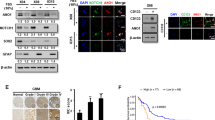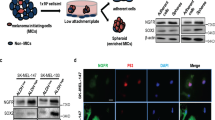Abstract
Long-term treatment with all trans-retinoic acid (RA) induces neuronal differentiation and apoptosis. However, the effect of short-term RA treatment on cell proliferation, migration and invasion of neuroblastoma cell lines (SH-SY5Y and IMR-32) remains unclear. RA induces expression of tissue-transglutaminase (TGase) and promotes migration and invasion after 24 h of treatment in SH-SY5Y cells, but not in IMR-32 cells. RA receptor (RAR) agonist (4-(E-2-[5,6,7,8-tetrahydro-5,5,8,8-tetramethyl-2-naphthalenyl]-1-propenyl) benzoic acid) and RAR/retinoid X receptor (RXR) agonist (9-cis-RA) promote expression of TGase, migration and invasion of SH-SY5Y cells, while RXR agonist has no significant effect. RAR antagonist blocks RA effect on migration and invasion, indicating that RAR receptors are required. Retinoid receptors are expressed and activated by RA in both cell lines. However, only transient activation of RAR is observed in IMR-32 cells. These findings suggest that different responses observed in SH-SY5Y and IMR-32 cells could be due to differential activation of retinoid receptors. Overexpression of TGase has no effect on migration or invasion, while overexpression of antisense TGase blocks RA-induced migration and invasion, indicating that other molecules along with TGase mediate RA effects. In addition to the long-term effects of RA that are coupled with cell differentiation, short-term effects involve migration and invasion of neuroblastoma SH-SY5Y cells.
This is a preview of subscription content, access via your institution
Access options
Subscribe to this journal
Receive 50 print issues and online access
$259.00 per year
only $5.18 per issue
Buy this article
- Purchase on Springer Link
- Instant access to full article PDF
Prices may be subject to local taxes which are calculated during checkout







Similar content being viewed by others
References
Abel EL . (2001). J Pediatr 138: 295–296.
Akimov SS, Belkin AM . (2001). Blood 98: 1567–1576.
Akimov SS, Krylov D, Fleischman LF, Belkin AM . (2000). J Cell Biol 148: 825–838.
Antonyak MA, Singh US, Lee DA, Boehm JE, Combs C, Zgola MM et al. (2001). J Biol Chem 276: 33582–33587.
Arvidsson Y, Hamazaki TS, Ichijo H, Funa K . (2001). Cell Death Differ 8: 1029–1037.
Biedler JL, Spengler BA, Chang TD, Ross RA . (1988). Prog Clin Biol Res 271: 265–276.
Carpentier A, Balitrand N, Rochette-Egly C, Shroot B, Degos L, Chomienne C . (1997). Oncogene 15: 1805–1813.
Castleberry RP . (1997). Pediatr Clin North Am 44: 919–937.
Chambaut-Guerin AM, Herigault S, Rouet-Benzineb P, Rouher C, Lafuma C . (2000). J Neurochem 74: 508–517.
Chambon P . (1996). FASEB J 10: 940–954.
Cianfarani S, Rossi P . (1997). Eur J Pediatr 156: 256–261.
Ciccarone V, Spengler BA, Meyers MB, Biedler JL, Ross RA . (1989). Cancer Res 49: 219–225.
Davies PJA, Stein JP, Chiocca EA, Basilion JP, Gentile V, Thomazy V et al. (1992). Retinoids in Normal Development and Teratogenesis. New York: Oxford University Press.
Denning MF, Verma AK . (1991). Biochem Biophys Res Commun 175: 344–350.
Eggert A, Grotzer MA, Ikegaki N, Liu XG, Evans AE, Brodeur GM . (2002). Cancer Res 62: 1802–1808.
Emionite L, Galmozzi F, Raffo P, Vergani L, Toma S . (2003). Anticancer Res 23 (1A): 13–19.
Farina A, Tacconelli A, Vacca A, Maroder M, Gulino A, Mackay A . (1999). Cell Growth Differ 10: 353–367.
Farina AR, Masciulli MP, Tacconelli A, Cappabianca L, De Santis G, Gulino A et al. (2002). Cell Growth Differ 13: 343–354.
Festuccia C, Bologna M, Vicentini C, Tacconelli A, Miano R, Violini S et al. (1996). Int J Cancer 69: 1–8.
Fesus L, Piacentini M . (2002). Trends Biochem Sci 27: 534–539.
Floyd EE, Jetten AM . (1989). Mol Cell Biol 9: 4846–4851.
Folk JE, Finlayson JS . (1977). Adv Protein Chem 31: 1–133.
Frappaz D, Michon J, Coze C, Berger C, Plouvier E, Lasset C et al. (2000). J Clin Oncol 18: 468–476.
Giannini G, Dawson M, Zhang X, Thiele C . (1997). J Biol Chem 272: 26693–26701.
Heyman RA, Mangelsdorf DJ, Dyck JA, Stein RB, Eichele G, Evans RM et al. (1992). Cell 68: 397–406.
Ishaq M, Fan M, Natarajan V . (2000). J Immunol 165: 4217–4225.
Isobe T, Takahashi H, Ueki S, Takagi J, Saito Y . (1999). Eur J Cell Biol 78: 876–883.
Juliano R . (1994). Cancer Met Rev 13: 25–30.
Kang SK, Yi KS, Kwon NS, Park KH, Kim UH, Baek KJ et al. (2004). J Biol Chem 279: 36593–36600.
Kim B, Leventhal PS, Saltiel AR, Feldman EL . (1997). J Biol Chem 272: 21268–21273.
Klaassen I, Brakenhoff R, Smeets S, Snow G, Braakhuis D . (2001). Int J Cancer 92: 661–665.
Leelawat K, Ohuchida K, Mizumoto K, Mahidol C, Tanaka M . (2005). Cancer Lett 224: 303–310.
Lotan Y, Xu X, Shalev M, Lotan R, Williams R, Wheeler T et al. (2000). J Clin Oncol 18: 116–121.
Mackay A, Ballin M, Pellina M, Farina A, Nason A, Hartzler J et al. (1992). Invas Metastasis 12: 168–184.
Maden M . (2002). Nat Rev Neurosci 3: 843–853.
Maden M, Holder N . (1992). BioEssays 14: 431–438.
Mehta K, Fok J, Miller FR, Koul D, Sahin AA . (2004). Clin Cancer Res 10: 8068–8076.
Meyer GE, Shelden E, Kim B, Feldman EL . (2001). Oncogene 20: 7542–7550.
Mohan K, Pinto D, Issekutz TB . (2003). J Immunol 171: 3179–3186.
Niles RM . (2004). Mutat Res 55: 97–105.
Palm-Leis A, Singh US, Herbelin BS, Olsovsky GD, Baker KM, Pan J . (2004). J Biol Chem 279: 54905–54917.
Pan J, Kao Y, Joshi S, Jeethendran S, DiPette D, Singh U . (2005). J Neurochemistry 10: 1–13.
Phuangsab A, Lorence RM, Reichard KW, Peeples ME, Walter RJ . (2001). Cancer Lett 172: 27–36.
Pola S, Cattaneo MG, Vicentini LM . (2003). J Biol Chem 278: 40601–40606.
Ponthan F, Borgstrom P, Hassan M, Wassberg E, Redfern C, Kogner P . (2001). Med Pediatr Oncol 36: 127–131.
Ponthan F, Johnsen JI, Klevenvall L, Castro J, Kogner P . (2003). Int J Cancer 104: 418–424.
Praise L, Lee J, Juliano RL . (2000). Sem Cancer Biol 10: 407–414.
Priglinger SG, Alge CS, Neubauer AS, Kristin N, Hirneiss C, Eibl K et al. (2004). Invest Ophthalmol Vis Sci 45: 955–963.
Qui H, Zhang Wm, El-Naggar A, Lippman S, Lin P, Lotan R et al. (1999). Am J Pathol 155: 1519–1523.
Reynolds CP . (2000). Curr Oncol Rep 2: 511–518.
Reynolds CP, Lemons RS . (2001). Hematol Oncol Clin North Am 15: 867–910.
Reynolds CP, Matthay KK, Villablanca JG, Maurer BJ . (2003). Cancer Lett 197: 185–192.
Rodolfo C, Mormone E, Matarrese P, Ciccosanti F, Farrace MG, Garofano E et al. (2004). J Biol Chem 279: 54783–54792.
Rossino P, Defilippi P, Silengo L, Tarone G . (1991). Cell Regul 2: 1021–1033.
Sato H, Kida Y, Mai M, Endo Y, Tanaka J, Seiki M . (1995). Oncogene 7: 77–83.
Schmidt ML, Lukens JN, Seeger RC, Brodeur GM, Shimada H, Gerbing RB et al. (2000). J Clin Oncol 18: 1260–1268.
Singh US, Pan J, Kao YL, Joshi S, Young KL, Baker KM . (2003). J Biol Chem 278: 391–399.
Smethurst PA, Griffin M . (1996). Biochem J 313 (Part 3): 803–808.
Soprano KJ, Soprano DR . (2002). J Nutr 132: 3809S–3813S.
Sporn MB, Roberts AB, Goodman D . (1994). The Retinoids: Biology and Medicine. New York: Raven Press.
Stahle M, Veit C, Bachfischer U, Schierling K, Skripczynski B, Hall A et al. (2003). J Cell Sci 116: 3835–3846.
Sugiura Y, Shimada H, Seeger R, Laug W, DeClerck Y . (1998). Cancer Res 58: 2209–2216.
Tucholski J, Lesort M, Johnson GV . (2001). Neuroscience 102: 481–491.
Voigt A, Zintl F . (2003). Med Pediatr Oncol 40: 205–213.
Westermann F, Schwab M . (2002). Cancer Lett 184: 127–147.
Xu C, Sneige N, Liu X, Nandagiri R, Lee J, Luckmanji F et al. (1997a). Cancer Res 57: 4992–4996.
Xu X, Sozzi G, Lee J, Lee JS, Paroeino U, Pilotti S et al. (1997b). J Natl Cancer Inst 89: 624–629.
Xu X, Sozzi J, Lee JS, Lee J, Shin D, Hong W et al. (1994). Cancer Res 54: 3580–3587.
Yao M, Bain G, Gottlieb DI . (1995). J Neurosci Res 41: 792–804.
Zang C, Liu H, Ries C, Ismair MG, Petrides PE . (2000). J Cancer Res Clin Oncol 126: 33–40.
Zhang L, Mills K, Dawson M, Collins S, Jetten A . (1995). J Biol Chem 270: 6022–6029.
Acknowledgements
Support for this work was in part provided by the Veteran Affairs VISN-17 and Scott and White resident training grant # 8271. We thank Gail V Johnson (University of Alabama at Birmingham, AL, USA) for providing stable cell lines of SH-SY5Y cells.
Author information
Authors and Affiliations
Corresponding author
Rights and permissions
About this article
Cite this article
Joshi, S., Guleria, R., Pan, J. et al. Retinoic acid receptors and tissue-transglutaminase mediate short-term effect of retinoic acid on migration and invasion of neuroblastoma SH-SY5Y cells. Oncogene 25, 240–247 (2006). https://doi.org/10.1038/sj.onc.1209027
Received:
Revised:
Accepted:
Published:
Issue Date:
DOI: https://doi.org/10.1038/sj.onc.1209027
Keywords
This article is cited by
-
All-trans-retinoic acid activates the pro-invasive Src-YAP-Interleukin 6 axis in triple-negative MDA-MB-231 breast cancer cells while cerivastatin reverses this action
Scientific Reports (2018)
-
Alpha-Synuclein Suppresses Retinoic Acid-Induced Neuronal Differentiation by Targeting the Glycogen Synthase Kinase-3β/β-Catenin Signaling Pathway
Molecular Neurobiology (2018)
-
Sub-micromolar concentrations of retinoic acid induce morphological and functional neuronal phenotypes in SK-N-SH neuroblastoma cells
In Vitro Cellular & Developmental Biology - Animal (2017)
-
The Hippo pathway member YAP enhances human neural crest cell fate and migration
Scientific Reports (2016)
-
Conformational changes and translocation of tissue-transglutaminase to the plasma membranes: role in cancer cell migration
BMC Cancer (2014)



